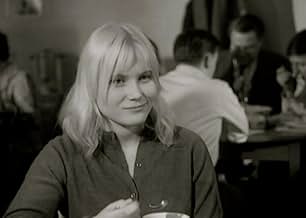Teenager David Clemens develops a hysterical fear that he will die if he comes into physical contact with another person. Perturbed, David's overbearing mother places him in a home for menta... Read allTeenager David Clemens develops a hysterical fear that he will die if he comes into physical contact with another person. Perturbed, David's overbearing mother places him in a home for mentally disturbed young people.Teenager David Clemens develops a hysterical fear that he will die if he comes into physical contact with another person. Perturbed, David's overbearing mother places him in a home for mentally disturbed young people.
- Nominated for 2 Oscars
- 6 wins & 7 nominations total
- Simon
- (as Matthew Anden)
- Carlos
- (as Jaime Sanchez)
- Josette
- (as Karen Gorney)
- Newsdealer
- (uncredited)
- Director
- Writers
- All cast & crew
- Production, box office & more at IMDbPro
Storyline
Did you know
- TriviaThe quote David utters in Dr. Alan Swinford's office, "When all at once I saw a crowd, A host of golden daffodils," is from the poem, "I Wandered Lonely as a Cloud" by William Wordsworth, 1807.
- GoofsWhen David and Simon are about to play chess, the board and pieces are set up incorrectly.
- Quotes
Lisa Brandt: What do you see when you look at me?
David Clemens: I see a girl who looks like a pearl. I see a pearl of a girl.
- ConnectionsEdited into Soufferance: A Preview of Adieu Tristesse (2011)
Keir Dullea is perfectly cast as David. His gradual transformation from a near automaton, virtually incapable of interacting with others, to someone a little less rigid is a fine feat of acting. Dullea has played rather stiff personalities in other movies, most notably "The Fox" and "2001," and one wonders if his portrayal of David is but an exaggeration of his own personality. Janet Margolin is equally accomplished in her portrayal of Lisa. Howard Da Silva is very believable as the benevolent psychiatrist Dr. Swinford, but his role is not terribly demanding and we come to know very little about him personally.
The black and white photography is effective and appropriate for the stark subject matter which is concerned exclusively with people and mental states. There are dream sequences that Alfred Hitchcock would have envied. The period details of the late 50s, early 60s (apparel, cars, home décor) are interesting.
When the kids from the home venture into the wider world their behavior is often viewed as bizarre and threatening by others. It is one of the strengths of the movie that in this context, our having been with the kids for awhile and gotten used to them a bit, their behavior is somewhat understandable. Maybe the next time we see someone behaving oddly in public we might reflect on this movie. However, it is a question whether the sympathy we come to have for David and Lisa is in no small part due to the fact that they are so attractive.
A psychiatrist might have a more accurate opinion, but for the lay person the story has many difficulties.
We are led to believe that mere socialization can lead to rapid improvement in treating some of the most intransigent mental disorders such as obsessive compulsive disorder and schizophrenia. While it is true that Dr. Swinford is always lurking in the background, he is not shown here to have any deeper insights or worth beyond that of a good friend (not to underrate the value of a good friend). While we come to understand that at the root of David's obsessions is a fear of death, we have no idea how he wound up in the condition he is in. Lacking any further evidence we are left with the implication that it has something to do with his having an absent and remote father and a domineering mother. But surely that could not be the total cause of an impairment as serious as David's. What was David like before we meet him? It is hard to picture him functioning in the day-to-day world.
We know even less about Lisa's background, nothing really. We are offered the common stereotype that schizophrenia is the same as multiple personality disorder, since Lisa alternates between being Lisa and Muriel. As to the others in the facility we get only a sketchiest idea as to why they are there; they all seem rather harmless.
There is no mention of drugs. Even in the early 60s, drugs would have played a part in treatment. Also absent is any mention of sex which would have to be a major consideration in dealing with late teens, emotionally disturbed or not.
We are left with the idea that things end on an upbeat note, however unrealistic. But, upon further thought, what is the future of David's relationship with Lisa? One cannot be optimistic about a sexual relationship - neither would be capable of caring for a child. And, if David is so afraid of simply being touched, there is going to be a long road ahead to any kind of sexual contact, let alone a satisfying relationship. And introducing sex into the mix of Lisa's problems is not going to simplify anything for her. Dr. Swinford is going to have to be more than a friend to deal with that situation.
David's obsession with clocks and time leads to a moment of great prescience. It is his secret dream to have a master clock that sends out radio signals so that all clocks can be synchronized and everyone can have the exact time. Interestingly this foreshadows the existence of the atomic clock at the National Institute of Standards and Technology and the existence of "atomic watches" several decades later.
While it is admirable that this movie tackles the important topic of mental health in an era when such was not common, it would have been a more valuable exercise if it had gone deeper.
- How long is David and Lisa?Powered by Alexa
Details
- Release date
- Country of origin
- Language
- Also known as
- David und Lisa
- Filming locations
- Production companies
- See more company credits at IMDbPro
Box office
- Budget
- $185,000 (estimated)
- Runtime1 hour 35 minutes
- Color
- Sound mix
- Aspect ratio
- 1.85 : 1
Contribute to this page



















